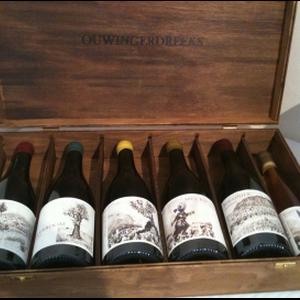A public holiday is an unusual day to host a wine launch, but with Eben Sadie of Sadie Family Wines, darling of the Swartland, lord of the Grape and Baby Jesus of the Sunday Times, nothing is normal anyway, so a sunny Monday saw a collection of wine hacks, customers and extreme grape farmers gather in Riebeek Kasteel to taste and celebrate the launch of his new Old Vines Series – the ‘Ouwingerdreeks’.
Eben certainly likes to do things differently. In a world where volume is king and tonnes mean money, it is very tempting for farmers to rip out older, less productive vines and plant new vines which will produce considerably more fruit. An old vine, on the other hand, has had a long time to send its roots deep into the soils in search of water and minerals which add flavour. It has had to struggle for survival over a far longer time and even though it produces fewer and fewer bunches of grapes over the years, those grapes increase in concentration and intensity. Generally accepted wisdom is that a vine is pretty old in this country if it is more than 30 years – that is, unless you’re Eben.
Along with viticulturist, Rosa Kruger, Eben has sought out tiny, forgotten plots of terrifyingly ancient vines – some of them more than 100 years old (since records only began in 1900, it is hard to accurately date them all). These include obscure varietals such as Red Semillon, Cape oddities like Palomino and some of the oldest Hanepoot in the country. Working with the farmers, they tenderly shepherded the fruit into bottles in the most natural way possible using no chemicals, no added yeasts and it would have been without a single drop of SO2 either, if it wasn’t that he needs to send the wine overseas. After all his hard work, he has ended up with around 250 bottles each of 6 different wines – a paltry return on his investment in financial terms.
But these wines aren’t about the money. Sure they’re expensive – a wooden case containing 5.5 bottles costs R3,504.82 (no, I’m not kidding! Where did that price come from?!) – and to be honest, I couldn’t justify spending two months of school fees on what for me, is one night’s drinking. But that really isn’t the point. The point is – that they exist at all. They are a piece of living, liquid history made in the same way our ancestors have made wine, using the very vines they nurtured, cared for, pruned and picked in the exact same way. I loved having the chance to taste them and I really, really hope that there are 250 people out there with less trouble paying the school fees than I, who can snap up a case and allow Eben to carry on his fascinating work.
Skurfberg 2009
Made from 3 different plots of Chenin Blanc, this is bright lemon in colour and shows an oatmeal nose with citrus and honeyed pears. Elegant layers of fruit, alcohol demands good, honest food.
Kokerboom 2009
Made from approximately 70% white and 30% red Semillon, all vines about 80 years old. Initial nose of herbal honey gives way to a rich, unctuous palate with hints of green leaves. Lemon peel finish, very satisfying wine.
‘T Voetpad 2009
A field blend of Semillon (red and white), Palomino and Chenin Blanc, this has a powerful nose of rosehips and honeyed biscuits. Intense spicy flavours with hints of lemons and high acidity. Slightly rustic and needs food to show at best.
Mev. Kirsten 2009
From the oldest Chenin vineyards in the Cape, now sadly dying as it enters its 90th year. A spicy, litchi-packed nose with an amazingly fresh palate and zippy acidity. A cinnamon/cream finish with baked pears.
Pofadder 2009
The only red made from 45yr old Cinsaut. Lovely purple colour, pale and luminous. Flavours of cherries and leaves take you straight to Southern France, tarry edge with licorice and lots of rustic charm. Not in the same class as the whites.
Eselshoek 2009 (Half bottle)
The maddest wine of a mad series! Made from 110 yr old Muscat d’Alexandrie (Hanepoot), this had to be picked unripe before the birds got to the grapes. They were then bunch-dried on lines under shading nets to give the wine an unprecedented acidity as well as sweetness. Old oxidative colour and nose, but incredibly fresh and lively palate with raisined fruit and a baked apricot finish.
For sales, email Delana at office@thesadiefamily.com.
What do you think? Worthwhile price for a piece of history or will you be sticking to Libertas?!

